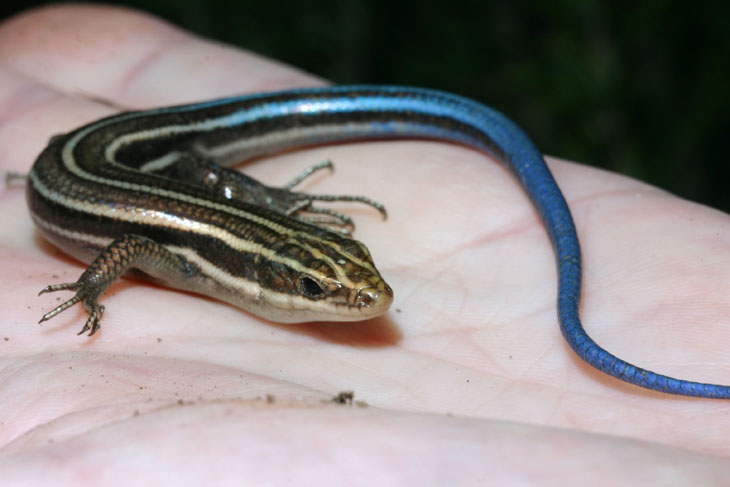Walkabout podcast – How to bake a human
I probably shouldn’t ever look at the searches that get linked here because of that title. Be patient, and it will become clear what it means.
I have, on numerous previous occasions, examined the various drives and emotions that we have from an evolutionary perspective – for instance, that morality is (almost certainly) an offshoot of inherent traits that make us a social species. We’re not individuals; we need others around, we seek their approval, and we see importance in community. It’s hard to argue that these did not benefit us hugely, and if we had the ability to abandon them right now and become as individualistic as reptiles, we would vanish from this planet in a short period of time, mostly because our offspring are pathetically helpless. But I haven’t tackled another aspect as often as I think I should have, so it’s time to look at humans as violent, selfish, and competitive.
If, right off the bat, that sentence made you uncomfortable or even defensive, good. That means your own traits towards community are stronger than the competitive traits. Yet, we cannot deny that we have them, even when we deny how often they manifest, or rationalize them as they do. The tricky thing about finding them distasteful is that we try to ignore or minimize them, instead of recognizing that they not only exist, they have strong affects on our decision-making processes.
First, let’s look at competition. Natural selection is a ‘competitive’ process, in that it on average promotes beneficial traits, weeding out those less beneficial or even harmful. I placed emphasis on the word “competitive” in the previous sentence to help differentiate it from the assumption that it implies a goal, rather than a process as simple as water vapor in the atmosphere collecting together until it’s heavy enough to overcome gravity as rain. The path that any species takes in developing over thousands of generations is guided only by out-reproducing others of the same species with slightly different genetic makeup. There’s no ‘goal’ possible; what results is simply what was more efficient from among the existing variables.
But then, there’s a curious development of sexual reproduction, where individuals start to actively choose which mate to have. This tiny change in attitude, this internal desire to be selective, is responsible for accelerating the selection process well above, for instance, random mating. Closely related comes the aspect of competing for favor, and this time the word does imply a goal, and specific activity. It is in any individual’s best genetic interest to reproduce, at the expense of other mate choices. It’s still natural selection, because no species can change their genetic makeup, and the traits selected as portraying a better mate are beneficial to the species – again, on average.
We cannot think of this in terms that are too simple, though. Kin selection is the idea that competitive traits (as well as cooperative traits) are very likely shared by members of our immediate family, so competition isn’t necessarily limited to the individual. For the millions of years that led to humans as we are now, life was a nomadic existence in small tribes or clans, very likely made up of closely-related individuals, so the social traits that we developed, allowing pack hunting and child care and even farming, also contributed to both survival and reproduction.
The other side of this is encountering another clan or tribe. They would not have the same genes, so selecting mates from outside the tribe isn’t as likely to promote the same genetic makeup, ‘watering it down’ and taking the chance that our own genes lose out to another more dominant collection. By nature, kin selection would be stronger – and by nature, desiring to maintain kin selection would be stronger too. Competition, at this point, extends beyond just mating behavior to the idea of the tribe or clan as a unit.
The difficulty herein is that selection has not, at least yet, produced something that is very specific. We still have the ability to decide what constitutes our ‘clan,’ whether it be our family, our alma mater or home sports team, our church, our country – whatever. At different times it flips back and forth, as we compete fiercely against our neighbor over social decorum but bond as a nation if we perceive a threat from outside that imaginary boundary. The key word there is “perceive,” because in reality there is precious little that actually constitutes a threat to us, especially to either our survival or our genetic heritage. And the clan perception is also arbitrary, since we cannot walk up to a state line and see the difference on the other side, nor even tell whether someone ‘over there’ is a native or visitor. Racism is such a prevalent trait in our species, despite the fact that we are all the same race, because by sight we can determine that someone is not from our immediate clan. It’s not that this has a rational meaning, any more than ‘our’ sports team, it’s only a vague way that we have been encouraged by our development to favor our own genes.
The really funny thing is, asexual reproduction, which does not require mating and thus does not mix genetic lines, fares less well that sexual reproduction, so we actually benefit from mixing. Seem contradictory? It is, to an extent, but again, random mating does not promote beneficial traits as well as selective mating. We tend to think in terms of what’s best and aim high, but selection can only use the choices available, which might provide a minuscule advantage that barely registers. An average benefit overall can still contain examples of extreme, even fatal, detriments – and in fact, we can find these easily. They’re just outnumbered by the beneficial traits.
In an earlier post, I mentioned that there are two kinds of competition, even though this may be simplifying things a bit too much: there is improving oneself, as in Olympic sports, and then there is the aggressive response, as in removing a threat. Ideally, we should concentrate on improving ourselves, since it’s hard to argue that this is not beneficial. But going back to the sexual selection idea (especially if we consider other species,) both can work. Whether an individual, built by their genes, is honestly better than all other suitors, or merely succeeds in chasing off other suitors, either way it gets to pass along its genes. The tribe or clan that did better in the hunt can also thrive by avoiding raids from other tribes, protecting those hard-won resources; alternately, stealing from others may at times be easier than hunting on one’s own. This sounds nasty, but it occurs frequently – bald eagles (which I take a certain perverse delight in pointing out serve as our national symbol) often nest near other species of fishing raptors and harass them into dropping their catches, gaining an easier meal than hefting their vast bulk out over the water in pursuit of their own fish. The smaller raptors expend less energy in catching meals and can thrive without eating everything that they capture. Again, our developed traits make us uncomfortable with this, but it still works.
The biggest issues, in our societies, stem from being prompted by these internal systems but not having a good way of differentiating the useful manifestations from the misfires. The “illegal alien” that crosses the imaginary line of our country is not any more or less likely to steal our jobs or taxpayer money than the newborn two doors away. The idiot driver that cuts us off on the road, while both dangerous and stupid, has not stolen our mate, job, food, or anything else, and only defines themself as someone we don’t want in our tribe, mostly because they did not display any community feelings towards us. So did we select them as ‘outsiders,’ or did they? Who cares? It’s total nonsense, prompted only by emotional reactions that are far too vague to be functional in the circumstance.
This desire to define the tribe is stronger than one might initially think; we draw lines all over the place, from political parties to social leeches, jocks to nerds, bitches to princesses (either of which, in our weird culture, can be compliments or insults)… and most especially, good to evil. These words are almost meaningless, but what we hope to express with them is ‘beneficial’ or ‘detrimental.’ A significant problem is that we draw these lines, and are quick to place someone else on the far side, but social interactions are never about just two choices, nor is labeling very accurate. If you’re coming to the conclusion that our two-sided thinking is another evolved trait, well, you might be right. Evolutionary psychology is, however, a haphazard field because it’s extremely difficult to tell what happened in the past, and what genes even promote certain types of thinking – we don’t even know where in the brain this might be seated, if it’s specific at all. And then there are the deep-seated cultural influences which are impossible to remove from any set of test subjects, meaning that any behavior may have nothing whatsoever to do with genes. Suffice to say, however, that falling for the “either/or” idea can make our decisions simplistic and wildly inaccurate, doing a huge disservice to the nuanced brains we tend to be very proud of otherwise.
Our brains rely, very strongly, on the emotional reactions that color every last bit of input – much as we might not like it, we are still creatures of instinct, even when those instincts are haphazard and have developed solely for other purposes. Yet, we have the ability to form rational decisions as well, and our desire to do so is also a trait, and an emotional system itself – all desire is. Yes, this does actually mean that we have an emotional encouragement not to rely on emotional encouragements, which helps to explain why rationalization occurs so rampantly in our species, even though the process itself sounds self-excluding. Yet we can override initial emotional reactions very easily, if we recognize that they’re not useful – ‘bad’ rather than ‘good.’ And this brings us around to the labeling thing again, because we always want to believe that we are good. What this really boils down to is that we feel it’s important to pass on our own genes. The abstract ideas of ‘good’ and ‘bad,’ or for preference ‘benefit’ and ‘detriment,’ should apply to actions and even decisions, because that’s the only way that benefit and detriment can apply. We can label ourselves, and others, with any concept we imagine, but this has absolutely no meaning to anything unless it can produce some specific change.
There are no rules that are going to come out of this; we cannot rationally say, “competition should only be expressed as forms of improvement,” because, at times, we really do need to protect ourselves and our families, even from members of our own species. Actually, that sentence is wildly misleading; it is almost entirely, by a huge margin, from members of our own species. It is this realization that, hopefully, can make us recognize that our evolved traits can often be more erratic than a rational approach, and our biggest saving grace is that we have a desire for rationality as well. We don’t get to choose the ingredients that evolution hands us, but we do have control over how much of each that we use to generate a successful recipe.
I need to tack on some thoughts here. Several places within this post I pointed out how evolution has produced some traits that can lead to less-than-reputable behavior such as racism. All too often, there are those who will take this to mean that we are destined or ‘meant’ to behave in this manner, and shouldn’t fight it. This confuses the vague emotional prods within our brains with specific instructions for behavior, as well as ignoring the traits that we have for social cohesion and ‘fairness.’ What we have within are very basic positive and negative reward systems, responses that can be triggered by a wide variety of stimuli – and these stimuli can also change, as indicated by how much our cultures have changed over the years, far faster than our species could possibly have evolved different responses. Some of this comes from different impressions or assumptions, such as how a once-liked actor or politician reveals through some action that they are not as we believed, and some of it comes from whether those around us approve or disapprove; the desire to ‘fit in’ overrides the desire to draw the “us/them” line where we once had it.
Note, too, that evolution works on two immediate aspects: the reproductive angle, where the continuance of the genetic line (or not) is part of selection; and the survival angle, where the individual must live long enough to reproduce. If you want to consider this the same thing, that’s fine, but it does mean that survival still depends on having enough cooperative individuals in one place to maintain the group benefit. Someone not viable as a mating choice to continue the genetic heritage (someone of the same gender, for a crazy example) can still assist with survival.
And then, there’s the ‘average benefit’ point, meaning that not every trait that we have is beneficial, or refined as much as it could be – we are not a finished product. When we can clearly see that some action or attitude is not going in a useful direction, we can easily halt it, and even develop those new perspectives outlined above. This is what critical thinking is intended to accomplish, and the very first part of it is pausing and wondering if some behavior is indeed considered and/or beneficial, or simply a reaction. Once this process is engaged, many of the little foibles that we evolved to possess, or that we misinterpret, can be overcome, rising above the simplistic function of reproductive success. This is the nice thing about brains and, curiously, how they evolved to be.























































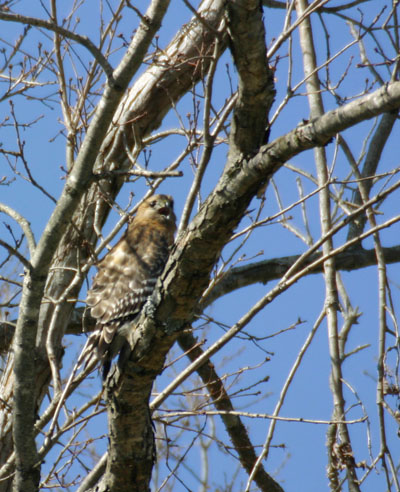 They make the red-shouldered hawks (Buteo lineatus) go into courting mode. The hawks are easy to spot because they’re anything but quiet about it, as indicated by the open mouths.
They make the red-shouldered hawks (Buteo lineatus) go into courting mode. The hawks are easy to spot because they’re anything but quiet about it, as indicated by the open mouths. As the nestlings become fledglings, they abandon the nest on their own in learning how to fly. This does mean that they’ll be found unable to fly, fluttering around at low level and even just sitting there staring at you. This is normal, and they should remain undisturbed. The parents are nearby, providing food and encouraging the flight attempts. Most bird species know enough not to give away their progeny’s locations to predators, or draw attention to themselves by moving a lot, so your ability to approach, or not being attacked by angry parents when you do so, means nothing at all. Again, observation is good here, as is knowing the calls of the species in question – the parents may be coaching their young towards them.
As the nestlings become fledglings, they abandon the nest on their own in learning how to fly. This does mean that they’ll be found unable to fly, fluttering around at low level and even just sitting there staring at you. This is normal, and they should remain undisturbed. The parents are nearby, providing food and encouraging the flight attempts. Most bird species know enough not to give away their progeny’s locations to predators, or draw attention to themselves by moving a lot, so your ability to approach, or not being attacked by angry parents when you do so, means nothing at all. Again, observation is good here, as is knowing the calls of the species in question – the parents may be coaching their young towards them. Baby raptors will tear you up – they know how to use the beak and talons very early (often on their siblings) and will not hesitate to protect themselves. And adult raptors
Baby raptors will tear you up – they know how to use the beak and talons very early (often on their siblings) and will not hesitate to protect themselves. And adult raptors  Also, and it pains me to have to always say this, but cute does not mean safe. Any animal can defend itself. I have never been bitten by a raccoon, despite their aggressiveness, but I have a scar and a touch of nerve damage from a grey squirrel – one, moreover, that was raised in a house. Rabbits and mice can bite the hell out of you. Shrews even have a toxic saliva. Yes, I am trying to scare you – if you’re scared, you’re cautious, which is better than incautious.
Also, and it pains me to have to always say this, but cute does not mean safe. Any animal can defend itself. I have never been bitten by a raccoon, despite their aggressiveness, but I have a scar and a touch of nerve damage from a grey squirrel – one, moreover, that was raised in a house. Rabbits and mice can bite the hell out of you. Shrews even have a toxic saliva. Yes, I am trying to scare you – if you’re scared, you’re cautious, which is better than incautious. 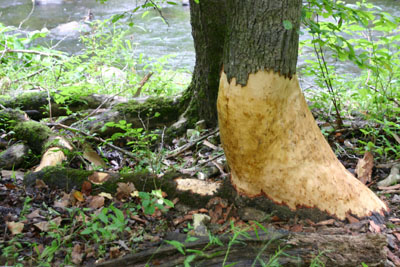 “Animals are doing damage to my property and need to be removed!” No. I can’t tell you how much this attitude annoys me, but that’s what a blog is for, right? Wildlife goes where the habitat is ideal, and pays no attention to humankind’s imaginary idea of “property.” First off, anyone should enjoy the opportunity to see behavior, something that is often hard to accomplish even when making the effort. If someone has wildlife around, chances are they aren’t in a high-rise apartment, which means they wanted to live with at least some vestige of nature visible; surprise surprise, it comes with other animals. While we might decry the damages to our gardens or landscaping, that’s part of the territory, just like road noise and power lines. Learn how to cope, and the ways to exclude animals from certain areas so we can have tomatoes. I’m sorry that a $500 tree was stripped, but no one should have planted something that was that appealing to the local species in the first place, and chances are, numerous appropriate trees had been cut down first so that the fancy landscaping could be put in its place (and I used to work for a landscaper, too.)
“Animals are doing damage to my property and need to be removed!” No. I can’t tell you how much this attitude annoys me, but that’s what a blog is for, right? Wildlife goes where the habitat is ideal, and pays no attention to humankind’s imaginary idea of “property.” First off, anyone should enjoy the opportunity to see behavior, something that is often hard to accomplish even when making the effort. If someone has wildlife around, chances are they aren’t in a high-rise apartment, which means they wanted to live with at least some vestige of nature visible; surprise surprise, it comes with other animals. While we might decry the damages to our gardens or landscaping, that’s part of the territory, just like road noise and power lines. Learn how to cope, and the ways to exclude animals from certain areas so we can have tomatoes. I’m sorry that a $500 tree was stripped, but no one should have planted something that was that appealing to the local species in the first place, and chances are, numerous appropriate trees had been cut down first so that the fancy landscaping could be put in its place (and I used to work for a landscaper, too.)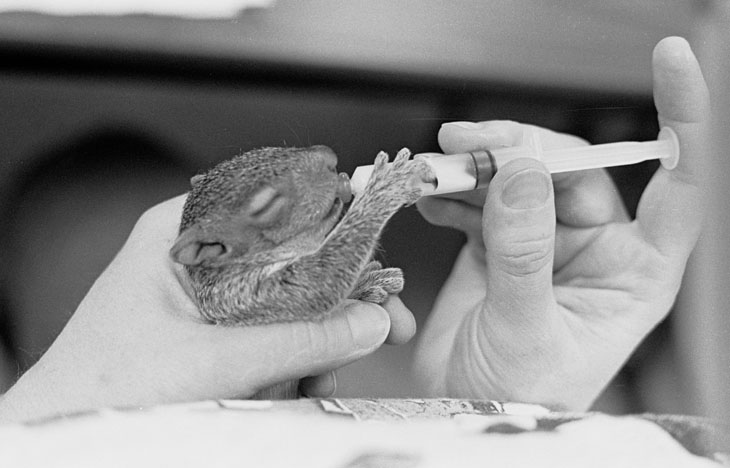
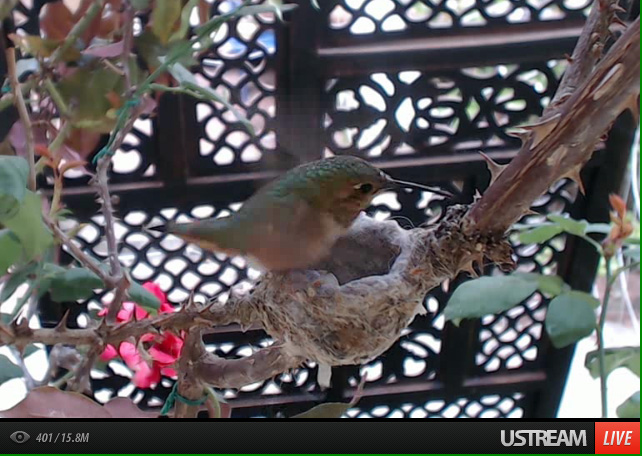
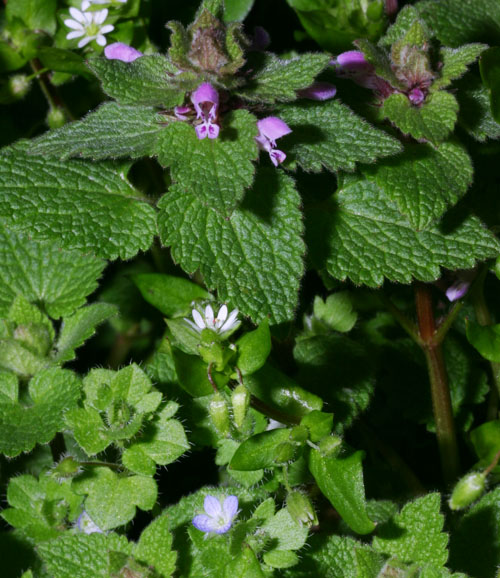 Nice day out there, so it’s time to go see if there’s anything to be captured in mid-February, with the added incentive that it’s Charles Darwin’s birthday and I should illustrate natural selection. Hmmmm.
Nice day out there, so it’s time to go see if there’s anything to be captured in mid-February, with the added incentive that it’s Charles Darwin’s birthday and I should illustrate natural selection. Hmmmm.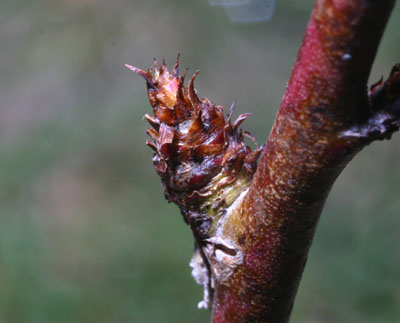 Last spring while preparing the mulch pile for use in the garden, I spotted a small sapling that had erupted from the rich soil, and in removing it I found it was actually an almond tree (Prunus amygdalus.) I have no idea when we tossed out an almond – they’re popular enough around the house that they get eaten quickly, unless they’re in questionable condition – but I tried transplanting it into the yard anyway. This isn’t really the climate for almonds, so I wasn’t expecting much, but what the hey. It grew about three times its height over the summer, never really appearing to thrive, and in the fall some visiting deer stripped all of the leaves from it. Yet today there appear to be new buds, so we’ll have to see what happens. It’s already weathered several days of sub-freezing temperatures, a light snowfall, and a freezing rain storm, plus last summer’s heat wave, so it’s not likely to see worse. The biggest challenge might be that under ten centimeters of topsoil sits Carolina orange clay, and if almonds don’t like that kind of substrate it’s not going to get very big.
Last spring while preparing the mulch pile for use in the garden, I spotted a small sapling that had erupted from the rich soil, and in removing it I found it was actually an almond tree (Prunus amygdalus.) I have no idea when we tossed out an almond – they’re popular enough around the house that they get eaten quickly, unless they’re in questionable condition – but I tried transplanting it into the yard anyway. This isn’t really the climate for almonds, so I wasn’t expecting much, but what the hey. It grew about three times its height over the summer, never really appearing to thrive, and in the fall some visiting deer stripped all of the leaves from it. Yet today there appear to be new buds, so we’ll have to see what happens. It’s already weathered several days of sub-freezing temperatures, a light snowfall, and a freezing rain storm, plus last summer’s heat wave, so it’s not likely to see worse. The biggest challenge might be that under ten centimeters of topsoil sits Carolina orange clay, and if almonds don’t like that kind of substrate it’s not going to get very big. I was surprised to see a caterpillar on the rosemary plant (Rosmarinus officinalis) – it was too big to have hatched this year, so it would have come through the winter. After a few pics, however, I nudged it to try and get it into a better position, and it simply collapsed and discharged a copious amount of brown goo. Ah. I guess it didn’t come through the winter after all. Whether a late hatching or an unlucky forager, my photo subject here failed to pupate in a reasonable time frame and probably got caught in one of the cold spells.
I was surprised to see a caterpillar on the rosemary plant (Rosmarinus officinalis) – it was too big to have hatched this year, so it would have come through the winter. After a few pics, however, I nudged it to try and get it into a better position, and it simply collapsed and discharged a copious amount of brown goo. Ah. I guess it didn’t come through the winter after all. Whether a late hatching or an unlucky forager, my photo subject here failed to pupate in a reasonable time frame and probably got caught in one of the cold spells.